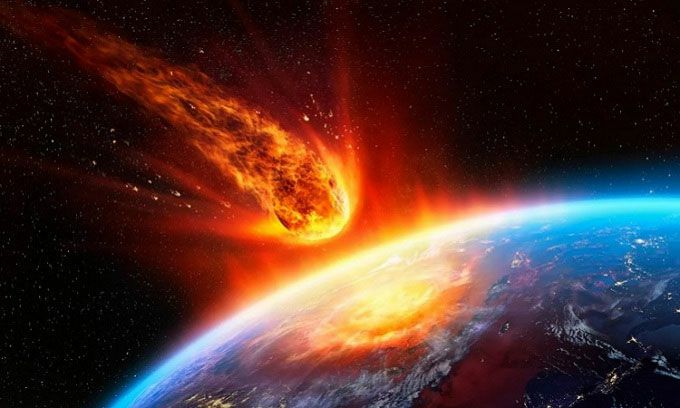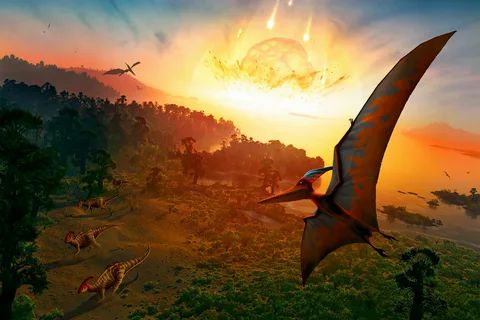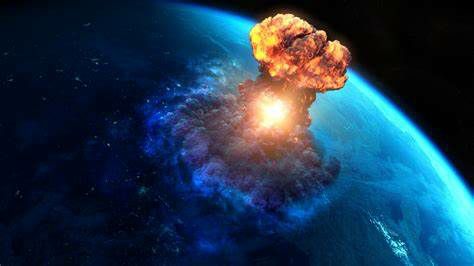The meteorite that wiped out the dinosaurs once created a tsunami 4.5km high.
The research findings published in the journal AGU Advances on October 4 reveal that the asteroid responsible for the extinction of the dinosaurs 66 million years ago triggered a tsunami of monumental proportions in the Gulf of Mexico.
By analyzing samples from more than 100 regions and creating digital models of the asteroid impact’s waves on the Yucatán Peninsula in Mexico, researchers uncovered evidence of a kilometer-high tsunami. Molly Range, the leader of the study from the Department of Earth and Environmental Sciences at the University of Michigan, explains that the tsunami was powerful enough to disturb and erode sediment in an oceanic basin halfway around the world.
The team reconstructed the trajectory of the tsunami shortly after the asteroid struck. Based on previous findings, they modeled the asteroid to be 14 kilometers wide and traveling at a speed of 43,500 kilometers per hour, which is 35 times faster than the speed of sound. The impact of the asteroid resulted in the extinction of many life forms, including non-avian dinosaurs, and wiped out three-quarters of plants and animals.
The researchers observed several destructive effects caused by the asteroid, such as wildfires that engulfed animals and the evaporation of sulfur-rich rock, leading to acid rain and prolonged cold winters worldwide. To gain further insights into tsunamis, Range and her colleagues analyzed the geological composition of 120 samples of marine sediments before and after the mass extinction event marking the end of the Cretaceous period. The results align with the model’s predictions regarding wave height and reach. The initial energy released by the tsunami generated from the impact was 30,000 times greater than that of the tsunami caused by the Indian Ocean earthquake, which claimed the lives of over 230,000 people in December 2004.
Immediately upon impact, the asteroid created a 100-kilometer-wide crater, ejecting a dense cloud of dust and soot into the atmosphere. Within just 2.5 minutes, the ejected material pushed the water wall outward, forming a 4.5-kilometer-high wave that crashed onto the shore, as simulated by the researchers. Ten minutes later, a 1.5-kilometer tsunami spread 220 kilometers from the impact site, inundating the bay in all directions. One hour after the impact, the tsunami exited the Gulf of Mexico and spilled into the North Atlantic. Four hours later, it surged across the Central American Seaway, separating North and South America at that time, and entered the Pacific Ocean.
The day following the asteroid impact, the tsunami traversed much of the Pacific and Atlantic Oceans, entering the Indian Ocean from both sides and striking coastal regions worldwide within 48 hours. The tsunami’s greatest strength was observed in the east and northeast, where the water moved at a velocity that likely exceeded 0.6 kilometers per hour, a rate capable of eroding fine sediments on the seafloor.
Certain areas, such as the South Atlantic Ocean, the North Pacific Ocean, and the Mediterranean Sea, were relatively spared from the tsunami’s effects. The team’s simulations indicate that water speeds in these regions were below 0.6 kilometers per hour.
Interestingly, the team also discovered ledges that emerged from the impact event on New Zealand’s North and South Islands, which are over 12,000 kilometers away from the Chicxulub crater in Mexico. Initially thought to be a result of local tectonic activity, the ledges’ age and position along the tsunami’s path led the team to conclude that they were caused by the asteroid impact.
Although the model did not assess coastal flooding, it revealed that waves off the Gulf of Mexico reached heights of over 100 meters and exceeded 10 meters upon reaching the North Atlantic and certain parts of the Pacific coast in South America.
Hits: 0











